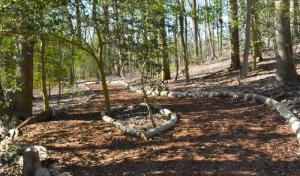Botanic Gardens set to stabilize Pepper Creek shoreline
Looking to preserve its 12.5 acres of forested wetlands, Dagsboro-based Delaware Botanic Gardens has submitted an application to the state for a major shoreline stabilization project.
According to a public notice issued April 1 by the Department of Natural Resources and Environmental Control’s Wetlands and Subaqueous Lands Section, the project has four phases. As proposed, the work will include building a 318-foot-long anchored-branch toe designed to attenuate waves, thousands of plantings and installing tree wads, the roots of fallen trees, to restore plant communities.
During a tour of the 37-acre botanic gardens April 3, Brian Trader, Delaware Botanic Gardens deputy executive director and director of horticulture, did not speculate as to why the tides of Pepper Creek continue to rise; he just said they were. He pointed to the exposed roots of a pine tree that used to be part of the woods, but is now part of the wetlands.
“Ten, 15 years ago, this tree’s roots seldom were covered with water. Now, it’s every high tide,” said Trader. “We can definitively say we’re experiencing sea-level rise here. It’s eroding the property and killing the trees.”
Trader joined Delaware Botanic Gardens in August, but he had spent the previous nine years at Longwood Gardens as the director of domestic and international studies. Standing in an untrailed portion of the Woodland Gardens, he said in addition to stabilizing the shoreline, the project will help protect the vernal ponds, found further into the forest, from the creek’s brackish water.
“The freshwater ponds are important for the amphibians, reptiles and birds that call these woods home,” he said.
The plantings will help stabilize the shoreline, but the anchored branch toe is key to the project’s future success, Trader said. Similar to bagged oyster shells or bulkheads, he said the anchored branch toe acts as a wave attenuation device. However, he said, this method will reuse fallen branches and small trees that were moved to clear the trail in the woods.
Describing the toe, Trader said logs will be anchored into the creek using a water-jet system, then other branches, logs and sticks will be woven between the logs, with periodic openings to allow water and aquatic life to circulate.
Trader said the project will also have an educational aspect for visitors. He said there are plans to build a viewing platform, heading from the wooded trail near the shoreline out into a portion of the wetlands.
Trader said the root wads will come from trees that have fallen over. They will be anchored into the wetlands, roots fanning into the air, and plantings will be incorporated within them, he said.
Trader said staff and volunteers cleared invasive species – primarily phragmites – from the wetlands to make way for a fill layer and plantings that will help keep the shoreline in place.
“There are trees with most of their roots exposed that are hanging on for dear life,” he said.
Trader said the expectation is to begin installing the anchored branch toe in May and the viewing platform in the fall.
Woodland trail expanded
Like just about everything else this year, Delaware Botanic Gardens has had to delay its spring opening. When visitors are allowed to return, among the things they’ll be able to take advantage of is the expanded trail through the Woodland Gardens.
When the gardens opened to the public in September, only half the forested area’s 12.5 acres had a trail. It closed for the winter Nov. 30, and since then, Trader said, staff and volunteers have been working hard to get the second half of the trail ready. He said the first thing was pulling out lots of thorned greenbrier by the roots.
“It’s not an easy thing to do,” he said, pulling out a vine from outside the trail line. “It grows horizontally and then sprouts upward.”
Triggered by the remnants of a dead fish along the trail, Trader said there’s at least one nesting pair of bald eagles in the trees along the new portion.
“The volunteers love them,” he said.
For more information go to www.delawaregardens.org.
Chris Flood has been working for the Cape Gazette since early 2014. He currently covers Rehoboth Beach and Henlopen Acres, but has also covered Dewey Beach and the state government. He covers environmental stories, business stories and random stories on subjects he finds interesting, and he also writes a column called Choppin’ Wood that runs every other week. He’s a graduate of the University of Maine and the Landing School of Boat Building & Design.



































































